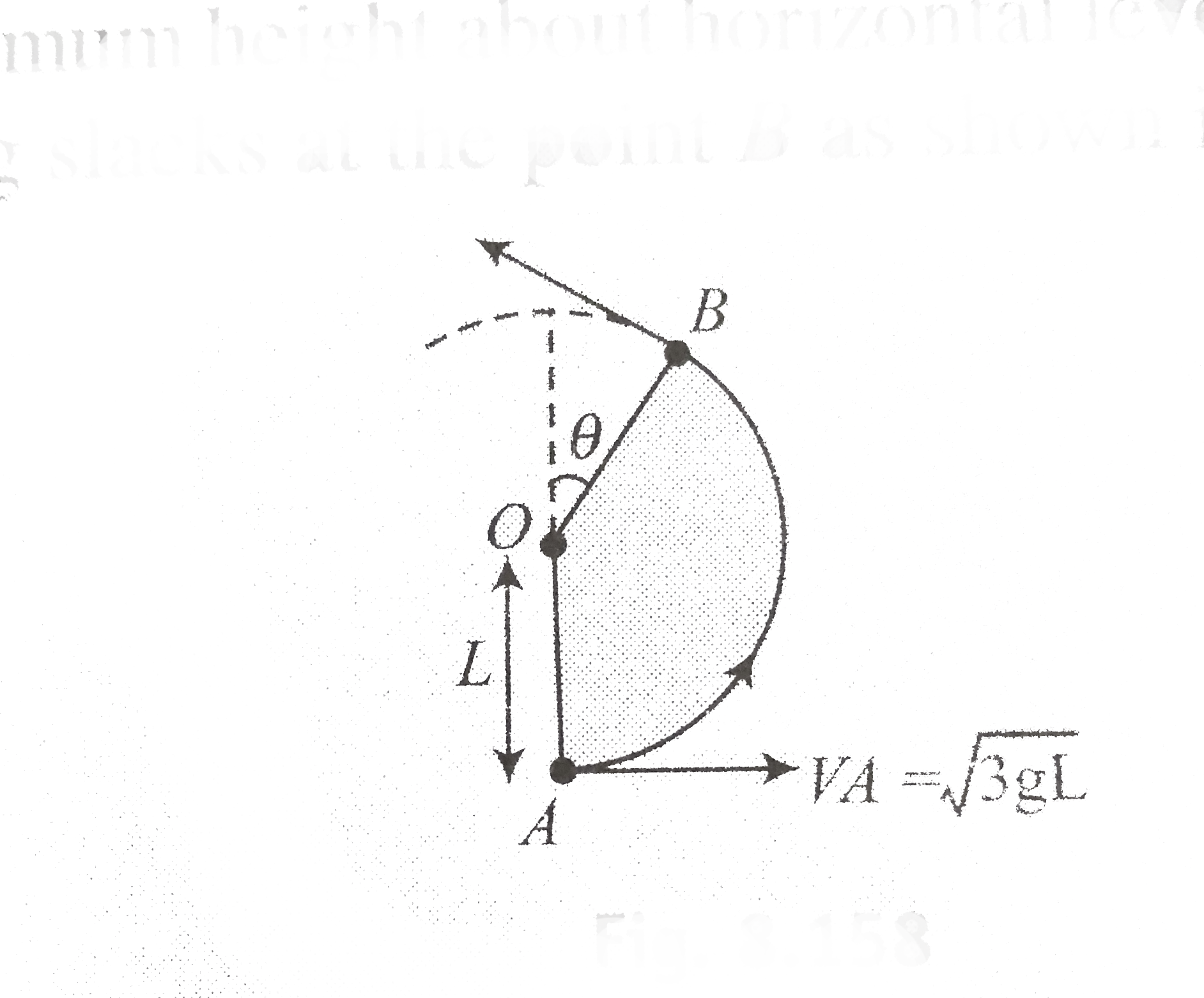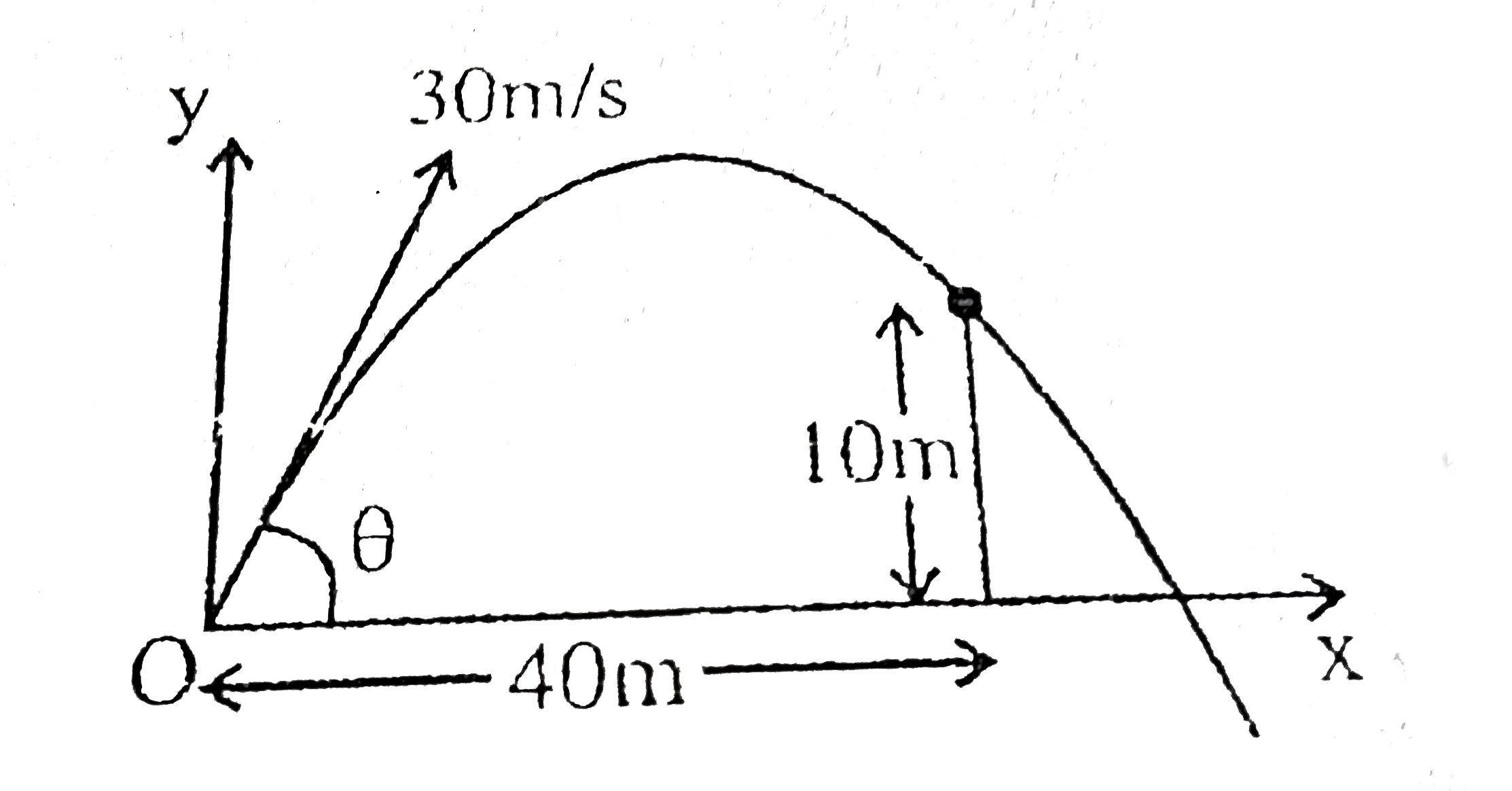A particle is projected at an elevation tan^(-1) ((4)/(3)) from a point O. The ratio of the range on the horizontal plane through O to the greatest height ascended above O is
2
3
4
5
The correct Answer is:B
To solve the problem, we need to find the ratio of the range of a projectile to the maximum height it reaches when projected at an angle of elevation given by θ=tan−1(43).
Step 1: Identify the angle and calculate its sine and cosine
Given:
tanθ=43
From this, we can construct a right triangle where the opposite side is 4 and the adjacent side is 3. Using the Pythagorean theorem, we can find the hypotenuse:
Hypotenuse=√42+32=√16+9=√25=5
Now, we can find sinθ and cosθ:
sinθ=OppositeHypotenuse=45
cosθ=AdjacentHypotenuse=35
Step 2: Calculate the range (R)
The formula for the range R of a projectile is given by:
R=u2sin2θg
Using the double angle identity, sin2θ=2sinθcosθ:
sin2θ=2⋅45⋅35=2425
Thus, the range becomes:
R=u2⋅2425g
Step 3: Calculate the maximum height (H)
The formula for the maximum height H is given by:
H=u2sin2θ2g
Calculating sin2θ:
sin2θ=(45)2=1625
Thus, the maximum height becomes:
H=u2⋅16252g=u2⋅16252g=8u225g
Step 4: Find the ratio of range to maximum height
Now, we find the ratio RH:
RH=u2⋅2425g8u225g=u2⋅2425g⋅25g8u2
The u2 and g cancel out:
RH=248=3
Final Answer
The ratio of the range on the horizontal plane through O to the greatest height ascended above O is:
3
Given:
tanθ=43
From this, we can construct a right triangle where the opposite side is 4 and the adjacent side is 3. Using the Pythagorean theorem, we can find the hypotenuse:
Hypotenuse=√42+32=√16+9=√25=5
sinθ=OppositeHypotenuse=45
cosθ=AdjacentHypotenuse=35
The formula for the range R of a projectile is given by:
R=u2sin2θg
Using the double angle identity, sin2θ=2sinθcosθ:
sin2θ=2⋅45⋅35=2425
Thus, the range becomes:
R=u2⋅2425g
The formula for the maximum height H is given by:
H=u2sin2θ2g
Calculating sin2θ:
sin2θ=(45)2=1625
Thus, the maximum height becomes:
H=u2⋅16252g=u2⋅16252g=8u225g
Now, we find the ratio RH:
RH=u2⋅2425g8u225g=u2⋅2425g⋅25g8u2
The u2 and g cancel out:
RH=248=3
The ratio of the range on the horizontal plane through O to the greatest height ascended above O is:
3
Topper's Solved these Questions
- BOOK - ICSECHAPTER - COMPETITION CARE UNITEXERCISE - NDA EXAM QUESTIONS55videos
COMPETITION CARE UNIT
- BOOK - ICSECHAPTER - CIRCULAR MOTION EXERCISE - MODULE 2 (FROM ROTATIONAL KINETIC ENERGY , WORK ,POWER)24videos
CIRCULAR MOTION
- BOOK - ICSECHAPTER - DIMENSIONSEXERCISE - SELECTED PROBLEMS (FROM CONVERSIONS OF ONE SYSTEMS OF UNITS INTO ANOTHER)9videos
DIMENSIONS
Similar Questions
A particle is projected with a velocity v so that its range on a horizontal plane is twice the greatest height attained. If g is acceleration due to gravity, then its range is
View SolutionA particle is projected from ground at some angle with horizontal (Assuming point of projection to the origin and the horizontal and vertical directions to be the x and y axis) the particle passes through the points (3, 4) m and (4, 3) m during its motion then the range of the particle would be : (g=10m/s2)
View SolutionTwo particles are projected at the same instant from the same point at inclinations α and β to the horizontal. If they simultaneously hit the top and bottom of a vertical pole subtending angle θ at the point of projection , find (tanα−tanβ).
View SolutionThere are two angles of projection for which the horizontal range is the same. Show that the sum of the maximum heights for these two angles is independent of the angle of projection.
View SolutionA particle is projected up an inclined plane of inclination β at an elevation ∝ to the horizontal. Find the ratio between tan∝andtanβ, if the particle strikes the plane horizontally.
View SolutionA particle in projected with velocity √3gL at point A (lowest point of the circle) in the vertical plane. Find the maximum height about horizontal level of point A if the string slacks at the point B as shown in figure.
 View Solution
View SolutionA particle is projected from a point O with an initial speed of 30ms−1 to pass through a point which is 40m from O horizontally and 10m above O. There are two angles of projection for which this is possible. These angles are α and β. The value of |tan(α+β)| is
 View Solution
View SolutionA particle is projected up an inclined plane of inclination β at na elevation ∝ to the horizontal. Show that
(a) tan∝=cotβ+2tanβ, if the particle strikes the plane at right angles
(b) tan∝=2tanβ, if the particle strikes the plane horizontally.View SolutionA particle is projected with a velocity 10 m//s at an angle 37∘ to the horizontal. Find the location at which the particle is at a height 1 m from point of projection.
View SolutionA particle is projected from the bottom of an inclined plane of inclination 30∘. At what angle α (from the horizontal) should the particle be projected to get the maximum range on the inclined plane.
View Solution

